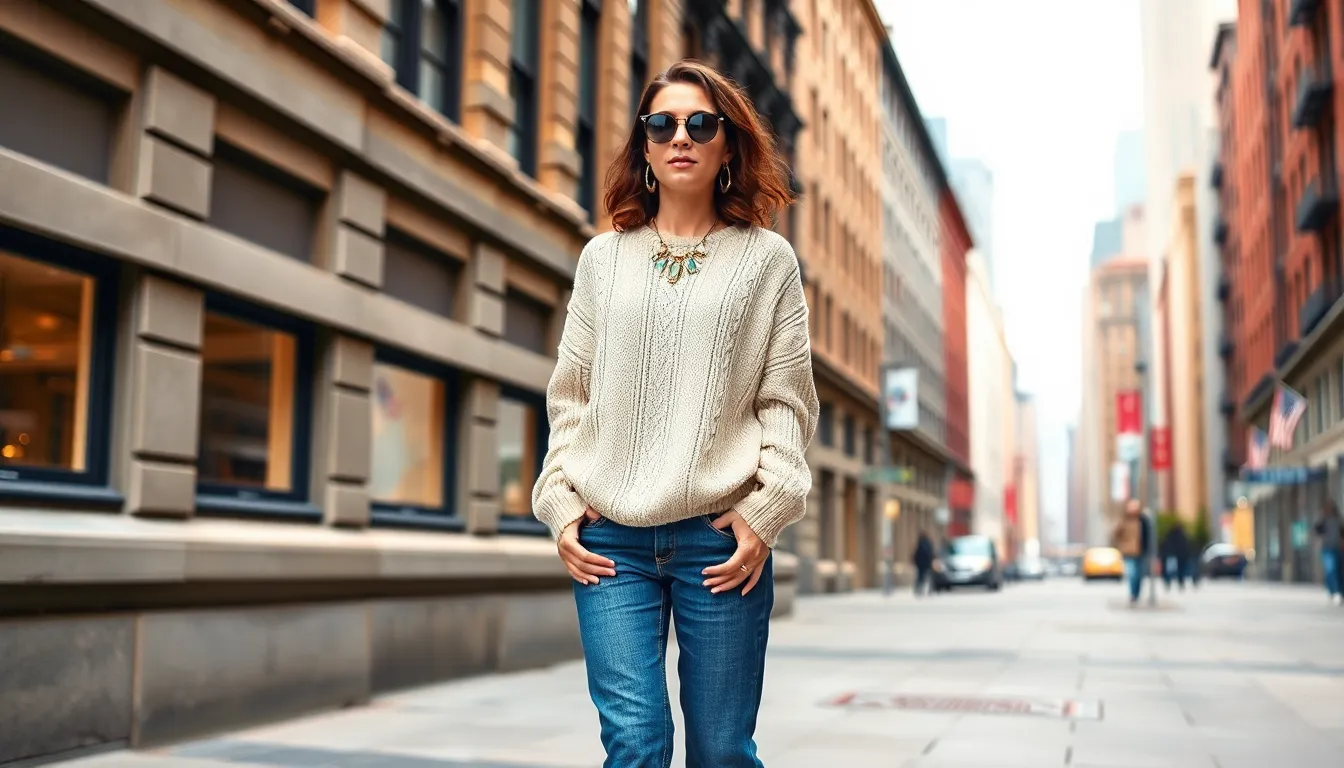Table of Contents
ToggleWomen’s fashion isn’t just about clothes; it’s a dynamic expression of identity, creativity, and confidence. From the boardroom to brunch, every outfit tells a story, and who wouldn’t want to be the author of their own chic narrative? Whether she’s rocking a power suit or a flowy sundress, each choice transforms her day into a runway moment.
Overview of Women’s Fashion
Women’s fashion represents a blend of creativity, culture, and comfort. Each season introduces fresh trends that influence styles and choices. Designers often draw inspiration from various sources, including art, nature, and societal changes.
The diversity of women’s fashion greatly impacts how individuals present themselves. Casual wear includes jeans, t-shirts, and leggings, while formal attire encompasses elegant dresses and tailored suits. Street style showcases boldness through mixing patterns and textures.
Accessories play a crucial role in enhancing outfits. Jewelry, bags, and shoes have transformative abilities, adding personality and flair. Women frequently use accessories to express emotions and workplace professionalism.
Seasonal changes dictate material choices and colors. Spring brings floral prints and light fabrics, while winter favors warmer, layered looks. Trends for each year are often shaped by fashion weeks around the globe, especially in cities like New York, Paris, and Milan.
Sustainability has emerged as a significant concern within women’s fashion. Eco-friendly brands prioritize ethical sourcing and production methods, appealing to conscious consumers. Vintage and thrift shopping also resonate with many, promoting recycling and unique discoveries.
Style icons and influencers often drive trends, with social media amplifying their reach. These figures can inspire women to adopt new styles and reinterpret classic pieces. Community engagement through social platforms allows women to share their fashion choices and receive feedback.
Current Trends in Women’s Fashion

Fashion trends in women’s wear continuously evolve, showcasing new styles and preferences. Recent months highlight several key categories of women’s fashion.
Casual Wear
Comfort remains paramount in casual wear choices. Oversized sweaters and relaxed-fit jeans dominate street style, providing both ease and effortless chic. Neutral tones, pastels, and earth shades create a calming palette while bold patterns and graphics add flair. Pairing casual outfits with trendy sneakers or chic ankle boots enhances overall look. Sustainability trends influence fabrics, with organic cotton and recycled materials on the rise. Vintage-inspired pieces, from high-waisted jeans to oversized tees, make a strong comeback, reflecting a growing appreciation for classic styles.
Formal Attire
Formal attire embraces elegance and sophistication in current trends. Tailored suits in vibrant colors make strong statements, moving away from traditional black and navy options. Midi and maxi dresses crafted from luxurious fabrics, like silk and satin, attract attention with eye-catching prints. An emphasis on unique silhouettes, such as puff sleeves or asymmetrical hems, elevates formal wear. Accessories, including statement jewelry and structured handbags, complement these outfits, ensuring every detail counts. Eco-conscious consumers seek brands that promote ethical practices, marking a shift in formal fashion choices.
Athleisure
Athleisure redefines comfort by merging functionality with style. Leggings and joggers paired with stylish crop tops remain popular choices for everyday wear. High-waisted silhouettes offer flattering fits that cater to various body types. Performance fabrics ensure breathability and moisture-wicking properties, enhancing usability beyond the gym. Layered looks, such as jackets or hoodies, provide versatility throughout the day. Bright colors and bold prints capture attention, allowing individuals to express their personalities. Increasingly, brands focus on inclusivity, launching collections that celebrate diverse body shapes and sizes.
Influential Designers in Women’s Fashion
Designers play a crucial role in shaping women’s fashion. They influence styles and trends that women embrace daily.
Emerging Designers
Emerging designers bring fresh perspectives and innovative concepts to women’s fashion. They often challenge traditional norms with bold designs and sustainable practices. Brands like Axiology and Christopher John Rogers have gained attention for their unique aesthetics. Axiology focuses on eco-friendly materials, while Christopher John Rogers emphasizes vibrant colors and striking silhouettes. Their creations appeal to a younger audience seeking individuality and sustainability. Not only do these designers create eye-catching pieces, but they also inspire a movement towards ethical fashion choices.
Established Icons
Established icons in women’s fashion continue to set standards and redefine elegance. Designers such as Chanel, Dior, and Versace command respect for their timeless craftsmanship and visionary designs. Chanel revolutionized the fashion world by introducing classic pieces like the little black dress. Dior’s “New Look” silhouette transformed women’s wear post-World War II. Versace has consistently celebrated bold prints and sensual aesthetics, pushing boundaries. These designers not only influence the industry but also inspire future generations of fashion enthusiasts. Their work serves as a benchmark for creativity, elegance, and innovation in women’s fashion.
Cultural Influences on Women’s Fashion
Cultural influences significantly shape women’s fashion, showcasing a blend of expressions from around the world. Global trends reflect cultural diversity and respond to shifting societal norms through fashion.
Global Trends
Influencers play a pivotal role in popularizing styles across different regions. For example, Korean street fashion has sparked widespread interest, leading to the rise of oversized clothing and vibrant colors in multiple markets. Likewise, the European emphasis on sophistication inspires tailored pieces often seen during fashion weeks. Fast fashion has contributed to the rapid spread of trends, allowing styles and ideas to transcend borders quickly. Additionally, sustainability movements shape preferences worldwide as consumers seek eco-friendly and ethical options. Whether it’s through bold prints or minimalist designs, global trends continuously evolve to reflect contemporary culture.
Historical Impact
Historical events have left a profound mark on women’s fashion throughout the decades. The women’s liberation movement of the 1960s introduced pants as a symbol of freedom and independence, transforming expectations around femininity. Similarly, the flapper era of the 1920s contributed to the embrace of shorter hemlines and more relaxed silhouettes, challenging traditional norms. Fashion during wartime emphasized functionality, leading to practical clothing choices that prioritized comfort. Each decade carries unique influences, reflected in fabrics, styles, and accessories. Through this lens, historical moments serve as critical touchpoints, enriching women’s fashion narratives with stories of resilience and change.
Sustainable Practices in Women’s Fashion
Sustainability influences the modern landscape of women’s fashion. Eco-friendly brands emphasize responsible materials, including organic cotton and recycled polyester. Vintage shopping continues to thrive as consumers seek unique garments while minimizing waste. Innovative designers focus on ethical production methods to reduce environmental impact.
Circular fashion has emerged as a key concept, prioritizing the reuse and recycling of clothing. Many brands design for longevity, encouraging consumers to invest in versatile pieces that withstand trends. Conscious consumers often seek certifications like GOTS (Global Organic Textile Standard) and Fair Trade to ensure ethical practices.
Transparency plays a crucial role in sustainability efforts. Shoppers increasingly demand information about the sourcing and production of their clothing. Brands responding to this demand emphasize traceability in their supply chains, building trust with consumers.
Collaboration further enhances sustainable practices. Initiatives like Fashion for Good unite industry leaders to develop sustainable solutions. Emerging brands often prioritize community engagement, promoting awareness about fashion’s impact on the planet.
Creative recycling and upcycling have gained momentum in the fashion industry. Many designers transform discarded materials into stylish garments, proving that sustainability can be fashionable. Collaborations between upcycled brands and mainstream retailers expand access to eco-conscious options.
Digital platforms amplify sustainability efforts through education and advocacy. Social media campaigns raise awareness about the importance of sustainable fashion choices. Influencers play a vital role in promoting eco-friendly brands, showcasing how style can align with values.
Sustainable practices in women’s fashion reflect a growing consciousness among shoppers. Awareness around environmental issues drives demand for eco-friendly brands, encouraging innovation and ethical commitments. As the fashion landscape evolves, sustainability remains at the forefront of consumers’ minds, shaping the future of women’s fashion choices.
Women’s fashion is more than just clothing; it’s a vibrant expression of identity and creativity. As trends evolve with each season, the influences of culture and sustainability continue to shape choices in style and material. With a growing emphasis on eco-friendly practices, today’s fashion landscape encourages conscious consumption and innovative design.
Emerging designers and established icons alike play pivotal roles in redefining elegance and inspiring future generations. The interplay of comfort and sophistication in casual and formal wear reflects the diverse needs of women everywhere. As fashion adapts to societal changes, it remains a powerful medium for self-expression and empowerment, paving the way for a more inclusive and sustainable future.




